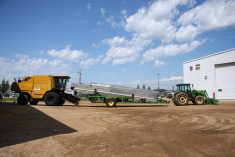Prices for diesel fuel, gasoline, natural gas and heating fuel fell sharply between August 2008 and August 2009, providing welcome relief for prairie farmers.
According to the latest consumer price index figures released by Statistics Canada, overall energy costs across Canada fell by 19.1 percent in the last year.
That figure included a 21.2 percent drop in the price of gasoline, a 38.1 percent decrease in natural gas prices and a 40.6 percent reduction in the cost of fuel oil and other fuels.
Pump prices for regular unleaded gasoline at self serve outlets averaged $1.01 per litre in August 2009, compared with $1.27 a litre last August.
Read Also

StatCan stands by its model-based crop forecast
Statistics Canada’s model-based production estimates are under scrutiny, but agency says it is confident in the results.
At the same time, month-to-month figures suggest fuel prices are on the rise.
Between July and August 2009, Statistics Canada reported a 2.6 percent increase in gasoline prices, a three percent increase in natural gas and 1.9 percent increase in electricity costs.
Canada’s overall cost of living has fallen by 0.8 percent during the past year. Annual CPI figures were down in eight of 10 provinces as of August 2009.
The largest yearly decreases were reported in Alberta (-1.7 percent), British Columbia (-1.1 percent) and Ontario (-1 percent).
Manitoba’s cost of living fell 0.4 percent during the same period.
Saskatchewan and Quebec were the only provinces to record an increase in consumer prices during the past year.
The overall cost of living rose 0.4 percent in Quebec and 0.8 in Saskatchewan, thanks largely to a 4.9 percent increase in food costs and a 2.9 percent increase in the price of shelter, which includes costs associated with rented and owned accommodations such as rental payments, mortgage interest costs, property taxes, insurance and home maintenance.
For farmers, the year-to-year decrease in fuel costs comes as a welcome break from last year’s record-high fuel and fertilizer prices.
A recent Agriculture Canada report suggested that fuel and fertilizer costs accounted for 16 percent of total Canadian farm expenses in 2007, or nearly $5.4 billion.
For every one cent per litre increase in fuel prices, Canadian farmers’ annual fuel bill increases by about $28 million.
Farm fuel prices reached unprecedented levels in 2008.
After increasing by 38 percent between 2004 and 2007, fuel prices rose another 28 percent in 2008 due to the strong international demand, tight crude oil supplies and political uncertainty in the major oil exporting regions.
Fertilizer prices also rose sharply last year, increasing 64 percent between 2007 and 2008, the report said.
Farmers generally respond quickly to major fluctuations in the price of farm fuel.
For example, when fuel prices rose 31 percent in 2000, farm fuel use decreased by about eight percent.
Two years later, when fuel costs dropped by 17 percent, farm fuel use increased by seven percent.
For more details from the farm fuel and fertilizer study, visit www.agr.gc.ca/mad-dam/ and click on Market Outlook Report.

















